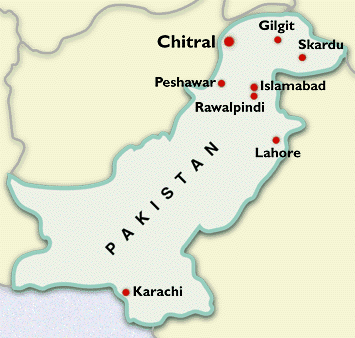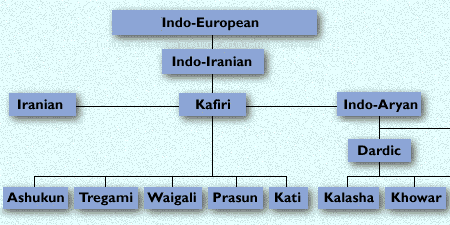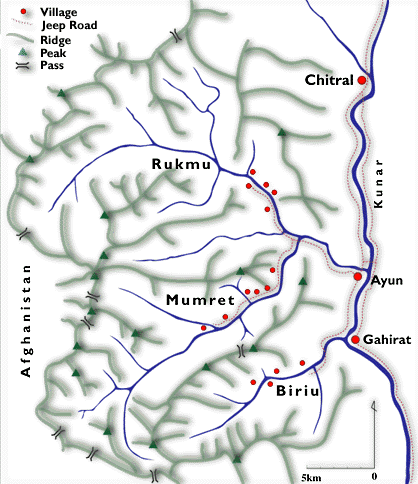|
|
the Kalasha People in Chitral Jun MARUYAMA |
|
|
|
the Kalasha People in Chitral Jun MARUYAMA |
|
This article was written in 1983.
![]() THE KAFIRS OF KAFIRISTAN
THE KAFIRS OF KAFIRISTAN
The land in the east of the Hindu-Kush range that lies between Pakistan and Afghanistan was called Kafiristan (the land of Kafirs), and there dwelled the Kafirs (the islamic word for "pagan") who rejected any conversion to Muslim and followed their own religion. Guarded by their geography and strength, it is assumed that 200 thousand Kafirs lived there. They drove away the armies of Timur (14C.), Akbar (16C.), Nadir-Shah (18C.), and were completely shut out from the exterior world.
But in 1895, Amir Abdul Rahman, the King of Afghanistan, conquered Kafiristan after a grueling battle and compelled them to convert to Islam. The name of Kafiristan was changed to Nuristan which means "the land of light". Thus, the main energy of the guerrillas that resist the Soviet army in Afghanistan today were Kafirs ninety years ago.

The Kafirs of Afghanistan were converted to Islam, but those of Pakistan who belonged to British-India after the Durand Line (1893) still followed their own religion. These are the Kalash-Kafirs and estimably 1700 of them live in three valleys of Chitral District, North West Frontier Province of Pakistan.
The history of the Kafirs remains obscure but some consider them to be the descendant of the armies of Alexander the Great ( B.C.327). They say that some Greek cultural elements can partly be identified in Kafiristan.
For example, the sports and games in Nuristan (wrestling and shot-put etc.) were supposedly practiced in the ancient Olympics. Secondly, their features are thought to resemble those of the South-European characteristics. Thirdly, it is believed that the Greeks had an influence on their music.
They consider that these "facts" seem to point to their Ancient Greek origin. But there is no conclusive evidence.
It is true that in "The Invasion by Alexander the Great's" by Arrianus and Plutarchos, the authors state that the army of Alexander reached "Nisa" which is thought to be Kafiristan. But the leader of Nisa proclaimed to him that they were the descendants of Dionysus (Bacchus) that came from Greece long ago. G.Woodcock (1966) thinks that Nisa is one of the colonies of Greece which was scattered widely throughout Achamenid Persia before the times of Alexander.
I think that of the Indo-Aryan expansion from the land near the Caspean Sea (B.C.1500-1000) those who came south in the first wave were the ancestors of the Kafirs. Those who came south in the second wave were the ancestors of the Indians, the third wave included the ancestors of the lranians.
Linguistically, the Indo-Iranian branch of the Indo-Aryan (Indo-European) family of languages are divided into three main groups : Indian, Iranian, Kafiri. The latter is considered to be the oldest, but there is no proof for this.
I do not deny the influence of Ancient Greece upon Kafiristan. This is a possibility, but the Greeks would have been in the minority, there --- the majority of the ancient Kafirs were a different race from the same original land as the Greeks. Any subsequent Ancient Greek influence would have been easily adopted by the Kafirs because of their common origin.
Indo-Iranian branch of Indo-European can be divided into three main groups : Indo-Aryan (Indian), Iranian, Kafiri (the language of the Kafirs). Geographically Kafiristan is located in the middle of India and Iran and thus linguistically the group of languages has similarities with the Indo-Aryan and Iranian groups. However unlike them it has no written script. Also the dialect of the Kafir languages (like Kati and Waigali) coincide with the distribution of the tribes.
However, Kalasha, spoken by the last of the Kafirs, is not in Kafiri. It is part of the Indian group of languages with Khowar (Chitrali) which is spoken in Chitral District. Kalasha is very similar to Khowar and even a small Kalasha child can speak it. Mixed in their language, we can identify Persian words used for abstract concept and modern Urdu for tools and articles etc. At present, about 2000 people speak Kalasha and 250 thousand speak Khowar.

A forty-five minute flight from Peshawar by PIA Domestic Airlines takes us to Chitral proper. By road it takes two days via Dir and Lowarai Pass (3177m).
Previously, the Kafirs predominated the whole Chitral area but in 16C. they were conquered by the Katur (Metar of Chitral) that came from Herat of Afghanistan and were converted to Islam. Even then, in Shishikui valley in the south of Chitral and Lutkoh valley in the north, a few unconverted Kafirs lived, but at the beginning of this century they were all converted to Islam.
Now the Kafirs only live in the three valleys along the branch of Chitral river (Kunar R.), Rukmu, Mumuret, Biriu (in Kalasha. Chitrali people and foreigners call them Rumbur, Bumburet and Birir). It is about two or three hours drive by jeep from Chitral proper and has become a popular place for the tourists to visit.

The Kalasha Valleys have extensive forests of Holly-Oak and Himalayan cedar. Walnut, Apricot, Apple, Pear and Mulberry trees abound near the villages.
Of the three valleys, Mumret is the largest. There are three villages of more than 200 people and two of about 60. But the valleys of Rukmu and Biriu are narrow and it is said that each of their populations are half the size of Mumret's population.
The villages are situated on the southern face of the hillside about 50-100 meters above the river. This protects them from invaders and the floods in summer, and at the same time helps to get sunshine during the winter. The snow that lies on the bottom of the ravine and in the shade do not melt until spring. In summer to avoid the sun, some people live in a second house built on the opposite side of the river.